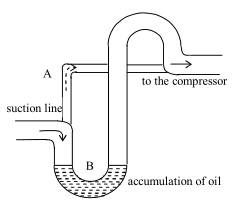The alignment of the crankshaft in the bed-plate should be checked at regular intervals to ensure th...
the shaft is not subjected to additional bending stresses which, under extreme conditions, may cause
crankshaft failure. A simple means of checking the alignment is to measure the change in the distance
between a pair of webs at each quarter of one cycle as distance from web to web measured at the open end,
more or less increases and decreases during one cycle, depending upon the misalignment of the shaft. More
information can be obtained by the method than measuring the sagging of the journal in the main bearing.
Crank-web dimensions, i.e. the distance between a set of webs, are reference values which are
determined during erection and are recorded in the Acceptance Records. Measurements are taken with a
dial gauge, the points at which it is to be taken for one cylinder in TDC, BDC positions and at exhaust and
control sides, two times for each. The average value is to be used and compared, and the value difference is
the crankshaft deflection.
A positive difference is an indication of a deflection of the particular throw in downward direction
whereas a negative value indicates a deflection in upward direction. The measurement taken in a ship that is
ready for acceptance will not agree with the measurements taken at the manufacturer's works, but they must
not, under any circumstances, exceed the specified limits for a realigned crankshaft.
The values obtained when the ship is under ballast will differ from those of the loaded ship and the
magnitude of the difference depends on the position of engine in the ship, the stiffness of the foundation
and the ship proper. Moreover, the measurements taken from the warm engine will not agree with the
measurements taken when the engine is cold. Onboard measurements should be taken as early as possible
in cold and warm condition of the engine and under various ship loads. These measurements are to serve as
reference basis for the evaluation of the measurements which are subsequently to be taken at regular
intervals. All readings and conditions under which they are taken are to be entered in the service records
together with the data. Such data could supply useful information to further investigation.
参考解析:
1. The purpose of alignment of the crankshaft is _____.
A. to decrease the additional bending stresses
B. to increase the additional bending stresses
C. to ensure that the shaft does not stand additional bending stresses
D. to ensure that it should be checked at regular intervals
2. Crank-web dimensions are taken with a dial gauge. For an engine with six cylinders, how many such measurements are to be taken?
A. Two times
B. Eight times
C. 36 times
D. 48 times
3. Which of the following statements is true?
A. The values obtained when the ship is under ballast should be as equal as those of the loaded ship.
B. The measurements taken from the warm engine will differ from those taken from the engine is cold.
C. The measurements taken in a ship will be not different from those taken at the manufacturer's works.
D. A negative value indicates a deflection in downward direction while a positive one indicates a deflection in upward direction.
4. The word "alignment" in this passage means_____.
A. misalignment
B. Realignment
C. arrangement in a circular line
D. arrangement in a straight line


 百度扫一扫练题
百度扫一扫练题
 关注千题库公众号
关注千题库公众号








